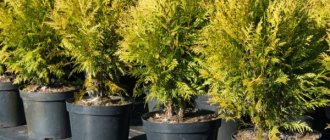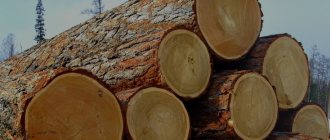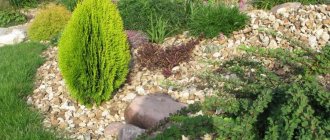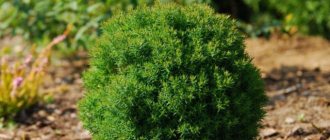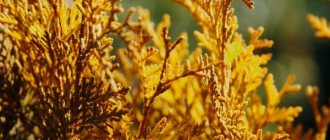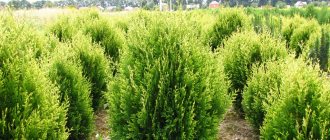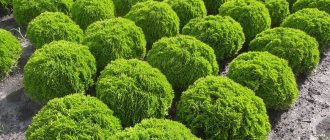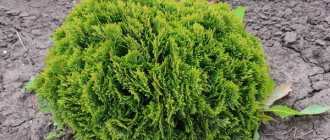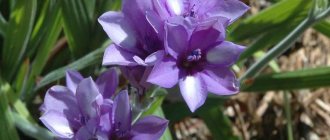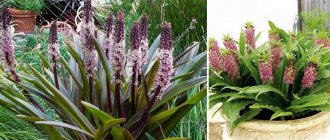Western thuja Hoseri: description of the variety
Thuya Hoseri: photo
A young species of western thuja Hozeri came to us from Poland, a densely shaped shrub, its annual growth is 5 cm. In good climatic conditions, the branches grow by 10 cm, no more. The shrub has many trunks, its branching occurs actively, and therefore a compacted crown is formed in the form of a sphere, and over the years in the form of an egg, a crown.
The needles of the Hozeri variety are soft, in the form of scales, bright green in color in the summer season and bronze in color in the winter season. Young shoots are painted silver. The plant changes its color depending on the time of year, but it looks great in any season.
The greenery of the shrub gradually changes over the course of 3 years, this is noticeable in the appearance of the thuja. In the spring season, the top of old shoots has flowers that appear one at a time. After the pollination process has occurred, small cones, 1 cm in size, are formed in place of the flowers.
Characteristic features of the “Khozeri” variety and its agricultural technology in mid-latitudes.
- An adult shrub does not require shelter for the winter at temperatures down to -29 degrees. If a more severe time is coming, the bushes can be easily covered.
- When planted in groups, thujas that grow in shaded areas and in sunny areas are identical in color and growth activity.
- Since the crown of the plant is compacted, it is rarely damaged by the wind, but at the same time does not tolerate drafts in the winter season.
- Shrubs, especially young seedlings, require regular watering.
- In mid-latitudes, the variety is immune to common diseases, but insects can harm it.
If you take good care of a dwarf, its growth and development will continue for 20 years or more. At the age of ten, the size of the thuja Hoseri barely reaches 80 cm in length. A small increase in weight per year makes it easier to form a bush or maintain it in its usual form through sanitary pruning. During sanitary pruning, old, dried and damaged shoots are removed.
Care
Timely care of the plant will save the gardener from problems with diseases and pests.
This variety requires the following care procedures:
- watering;
- feeding;
- mulching;
- pruning;
- in the northern regions - shelter for the winter.
If you do not neglect the above procedures, the plant will delight the eye with beautiful needles all year round.
Also learn about how to properly plant pine trees on your property.
Watering and fertilizing
A thuja seedling needs constant irrigation until new branches grow on it, so watering during the first 2 months should be done as the earthen clod dries out. Further irrigation is carried out at the rate of 8 liters per bush every 7–10 days.
To ensure that the crown maintains its beautiful appearance, you can sprinkle it every week.
To keep the coniferous plant beautiful and healthy throughout the warm period, fertilize with Zircon at intervals of 10–14 days. To prepare the solution, take 1 ampoule of the product per 10 liters of water. When processing, it is necessary to moisten each plant generously.
This solution is also effective not only for preserving the beauty of the crown, but is also used as root feeding. It stimulates root growth and is also effective in combating many strains of fungus.
Using the Zircon preparation for watering requires the same dosage as for irrigating the crown (1 ampoule per 10 liters of water). The prepared solution is used at the rate of 10 liters per 1 m².
Trimming
In order to carry out the pruning procedure, you will need well-sharpened garden tools: pruning shears, scissors with long blades, and a pair of gloves to protect your hands. Thuja Hoseri is an ornamental variety , so it does not need formative pruning, except in cases where the gardener wants to cut a certain shape from the bush.
Did you know? Thuja needles and branches are rich in ascorbic acid, so in the Middle Ages sailors used them to fight scurvy.
.
Every year in the spring, the plant needs sanitary pruning, which consists of removing dried, diseased or insect-damaged branches.
Thuja Hoseri in landscape design: application
Thuja Hoseri in landscape design
The shrub is grown singly, in decorative groups, in low compacted borders. After all, the characteristics of the variety can allow this. Thuja looks great in a garden plot in a flower bed or container. A miniature crown can make it possible to decorate staircases, verandas, terraces, roofs, and balconies with bushes in pots. A universal variety that looks good in different lighting conditions, in combination with various garden plants.
Western Thuja Hoseri is planted along the paths of alleys, parks, rock gardens and rock gardens. The low growth of shrubs and their tolerance of shaded areas contribute to the revitalization of the lower tier of the garden area, visual support for planted ferns, tall grasses and cereals.
The thuja border has excellent tolerance to thickening, it is easy to form, and it stays in a certain shape for a long time. Therefore, there is no need to frequently trim the green mass and correct the crown.
In open spaces, the variety stands out for its rich coloring and can separate zones. A beautiful background for the rich green crown of the thuja is tall deciduous and flowering shrubs, various conifers, plants from the Cypress Family, and fruit trees. The thuja in the flower beds contrasts amazingly with the variegated plants that cover the soil.
Use Cases
Hosery will decorate a rock garden, rocky and heather garden. It can be planted on the sides of garden paths, alone or in groups against the backdrop of a lush green lawn. The compositions of this coniferous plant with ornamental grasses, fragrant herbs, flowering annuals and perennials, and ferns turn out wonderful. Spiraea, viburnum, derain, and garden barberry will serve as good companions for it. It is appropriate to place ground cover plants in front of the bush, which will look like a variegated carpet. The variety is suitable for growing in containers. Thus, it can be used for landscaping balconies and roofs.
Methods of propagation of the variety
There are 2 ways to propagate the western thuja Hoseri - cuttings or seed. Fruit ripening in cones occurs late in autumn. They often remain for the winter under snow cover or are immediately planted in a permanent place during the cold winter season and germinate in the spring season.
The interval between seeds when planting is 25 cm, no less. If seedlings appear at the same time, then it is necessary to thin out the plants more than once. The soil must be mulched. The sprouts that appeared in the spring season are thin, vulnerable and tender. Shrubs up to three years old should be carefully looked after. When the bushes are five years old, they can be replanted.
Although shoots appear quickly, the fruits are rarely used for germination purposes. The seed propagation method is a long and labor-intensive process; it is used, for the most part, by experienced gardeners and scientists. Propagation by seeds does not always make it possible to obtain bushes that have inherited all the maternal characteristics. But cuttings help to obtain quick results and full varietal compliance of the bred shrubs.
Western Thuja Hoseri: photo
Thuja Hoseri: propagation by cuttings
The branches are cut late in autumn, 15 cm long.
The needles are removed from the lower part of the stem, and the shoot is dipped in a solution of the drug to stimulate the growth of the root system. It is necessary to withstand for a day.
The place for planting petioles should be protected from drafts and direct rays of the sun. It is in this area that the petioles are buried. Or rooting of cuttings occurs in containers with lightweight soil. It is important that the container contains a drainage system.
When warm weather arrives with temperature conditions of +22 degrees, the root system of the seedling begins to actively form. If the petiole has adapted, it will show you this by its growth.
If you grow thuja at home, then the planted plants need to be covered with film material, thus creating a greenhouse. Removal of the cover is carried out after the sprouts have appeared. The petioles are transplanted into open ground after a year.
Young seedlings of the spherical thuja Hoseri need shelter for the winter. In this case, the plants are covered with spruce branches and non-woven material. With this method of propagation, the thuja will grow a compacted apical part and several supporting trunks in 2-3 years.
a brief description of
Thuja occidentalis Hoseri was bred in Poland. It is distinguished by its short stature - the height of an adult shrub reaches only 60-90 cm, while other varieties can reach a height of several meters.
This is a shrub with several trunks, from which straight scaly shoots extend, forming a dense spherical crown. The color is dark green, changing to bronze and brown in autumn.
The needles are replaced every three years. This is done gradually, so the process is invisible. It grows slowly, does not add more than 5 cm per year.
Thuja hoseri occidentalis
In the year of flowering, the tops of the shoots are overgrown with single flowers, characterized by monoecy. As they fade, they give way to small cones, shaped like an egg 1 cm in size.
How to remove double-sided tape from a car, plastic, glass, furniture and other objects
A brief description of the benefits of Thuja Hoseri:
- frost resistant;
- not afraid of strong winds;
- easily tolerates pruning;
- loves warmth and sun;
- not too fussy to care for.
Thanks to these characteristics, it is very popular among gardeners in the middle climate zone.
Despite its unpretentiousness, some nuances should still be taken into account when breeding this plant.
How to properly plant the spherical thuja Hoseri
To decorate your garden plot, you need to buy three-year-old seedlings that grew in nurseries. Such shrubs are compact, the ball-shaped crown is already noticeable, and the appearance is already decorative.
Thujas in containers are easier to transport and can wait for weather conditions suitable for planting without losing their qualities. If the root system of the variety is open, then the seedling must be urgently transplanted into the ground.
When can plants be planted?
Western Thuja Hoseri can be planted with an open root system in the spring, after the ground has warmed up, but before shoots begin to grow. Planting in the autumn season begins after the leaves have fallen in the garden area, 3-4 weeks before constant cold weather.
Plants with a closed root system can be planted in the ground throughout the growing season. Planting in the autumn season will contribute to the successful rooting of thuja. If seedlings are planted late, they will freeze.
How to choose a site for planting and prepare the soil for Western Thuja Hoseri
The globular thuja Hoseri can be cultivated in diffused light or in partial shade. Shaded areas are prohibited for growing any conifers. It is also not worth planting thuja close to tall trees, because they will cause the thuja to lose its decorative properties. If you plant plants in an open space where there is a lot of sun, you need to carefully monitor the soil moisture and water it in a timely manner. If the area is constantly blown by winds, then the bush clearly has no place here, because the soil and air will quickly dry out, and the thuya will not like this.
The variety likes moist, fertile soils, but if the moisture stagnates or there is a large amount of precipitation, the planting site needs to be drained. The drainage system is located at the bottom of the planting pit and consists of a 15 cm layer of sand, gravel or expanded clay.
The descriptive characteristics of the variety indicate that it can grow on any soil. Nevertheless, it is recommended to cultivate thuja on sandy loam, loam, moderately nutritious soils of a slightly alkaline or neutral type. In acidified soils, it is necessary to add lime or dolomite flour when digging, and add wood ash when planting. If the soil is depleted and heavy, then its contents are completely removed.
The soil mixture should consist of the following components: humus or soil from a garden plot, coarse river sand, dark peat, in a ratio of 2:1:1, a complex of fertilizers for conifers, follow the recipe.
Organic fertilizers, especially fresh manure, are not used when planting the variety. In order for the seedlings to take root successfully, it is only necessary to add a complex mineral composition.
Progress
It is recommended to prepare the planting site in advance. The hole must be dug 60 cm deep. The interval between bushes when planted in a group is 80 cm. The interval must be reduced if a large number of seedlings will be cultivated, for example, in order to form a compacted border.
- A drainage system is placed in the prepared hole.
- The prepared soil mixture is poured on top.
- The seedling is installed in the central part of the hole so that the root collar is above the surface layer of soil.
- All empty spaces must be filled with earth, and each layer must be compacted slightly with the palm of your hand.
- After the plants are planted, a small earthen bank needs to be built around the circumference of the thuja for watering.
The soil ball in the container needs to be stirred and the roots untangled before planting. The intertwined roots curl up in the container and grow inward due to the fact that the seedling does not have enough space. Bushes with such a neglected root system take a long time to adapt.
After planting, each plant is watered with 10 liters of warm water and the surface layer of soil is mulched with crushed bark, sawdust, and peat.
Place in the garden
Thuja is hardy and unpretentious. It can grow perfectly anywhere. However, under more suitable conditions, its decorative qualities will be much higher. It is better to choose well-lit, but slightly shaded places for planting, where there are no drafts or wind. Under the influence of direct sunlight, the thuja “hoseri” can dry out, and if there is a lack of light, it can lose its splendor and beautiful shade. It is important to make sure before planting that neighboring plants do not obscure the shrub with their shadow.
The most suitable soil will be peat and clayey, moderately nutritious sandy loam. When planting in heavy soil, a good drainage layer should be created. Its thickness should not be less than 15 cm. Groundwater located close to the surface will not harm the plant.
How to properly grow and care for the globular thuja variety Hoseri
Although the variety is considered unpretentious, it still needs to maintain certain soil parameters. Loose soil promotes the necessary respiration of the root system; if there is not enough air, then growth is inhibited and the decorativeness of the crown fades. Constantly loosening to great depths is prohibited, because the root system is close to the soil surface.
The variety is not tolerant of dry periods. If the soil is left in a dry state for a long time, especially in hot weather, the plant begins to wither and the needles turn yellow. These bushes will have to be completely pruned, and they will also take a long time to recover.
Mulching is suitable in this case. It will satisfy the plant’s soil requirements. Mulch consists of sawdust or bark. Its layer is 5 cm. Mulching will protect the soil from winds, crust formation and water loss.
Thuja Hoseri: when and how to water
- The application of watering depends on the time of year and the age of the bushes.
- Irrigation of the soil under the bushes is carried out if necessary, but the soil should always be maintained in a slightly moist state.
- For adult shrubs, watering is applied once/7 days, approximately 10 liters per bush.
- In hot weather, to prevent the effects of dry air, the bushes are sprayed in the evening.
- Before the onset of cold weather, abundant moisture-recharging watering is carried out, which will help the plant successfully endure the winter season.
If shrubs are protected from sunlight by tall plants, they will suffer less from drying out soil and air. In open spaces, plants may burn, this will be noticeable by a change in color at the tips of the shoots. If you add a lot of moisture in the evening hours, then thuja will cope well with the hot period.
Feeding
The variety grows well on all types of soil if fed in moderation. There is no need to feed too much, especially with organic matter. An excess of manure or bird droppings will cause the plant to overeat nitrogen and acidify the soil.
Principles of fertilizing
- If the planting hole was laid correctly, then the seedlings do not need to be fed for about 2 years.
- Adult plants are fed early in the spring with complexes for conifers. It is mandatory to fertilize after the spring pruning procedure, when rotted organic fertilizers can be applied to the tree trunk circle.
- In order for the roots to awaken and adapt faster, watering is carried out with the addition of the preparations “Epin” or “Kornevin”.
- In the autumn season, together with pre-winter watering, you can add small doses of potassium and phosphorus.
- During the growth period, you need to feed if the bushes are really weakened or the needles are damaged by sunlight.
Universal mixtures for feeding: “ Khvoinka”, “Zdraven”, “Good Power ”. Solutions must be dosed strictly according to the recipe to avoid burns to the root system.
Circumcision procedure
- Plants of this variety grow a little per year and themselves grow a crown in the shape of a ball. There is no need to trim bushes often. In the spring, it is necessary to inspect the bushes and remove all branches that have been damaged by frost. If it is necessary to form a crown, pruning is carried out before the juveniles appear.
- Mature shrubs shed their needles inside the dense bushes. To prevent the insides from being exposed, the skeletal branches are thinned out from time to time to allow light and wind to enter. Dead needles are removed.
- If you need to strongly shape the bushes in the borders, pruning is carried out again after a year. It is necessary to give the bushes time to recover and ensure the growth of shoots.
Thuja Hoseri: how to prepare plants for winter.
The variety is not afraid of frost. If there is a large amount of snow, the shrubs tolerate the winter well; they do not require additional covering.
The variety suffers more from a cap of snow or ice. After all, it can break the crown with its mass. For this reason, it is recommended to tie the branches together before cold weather, without tightening them.
Late in the fall, the bushes are inspected, damaged, dried or old shoots are pruned. After abundant watering, the soil should be mulched with a 10 cm layer. It is necessary to cover the thuja if the winter season is harsh. Good protection is huts made of branches or perches that are covered with non-woven material.
How to plant?
Despite the fact that this variety tolerates frost well, it is recommended to plant before the onset of cold weather so that the plant has time to take root in the soil. Planting is usually carried out in autumn or spring. Due to its unpretentiousness, this variety can grow almost anywhere. However, in order to facilitate further care of the plant, it is necessary to provide it with the most comfortable growing conditions. To plant, you must find a place on the site that meets the following requirements:
- It is desirable that the selected area be well lit, but it is also possible to plant thuja in shaded areas.
- the site should not be subject to constant drafts, and it is also advisable that the place be protected from strong gusty winds.
- the surface at the landing site should be relatively flat so that water does not stagnate there during snow melting or heavy rains.
As for the composition of the soil, the best option would be light soil. To prepare the substrate, peat, sand and ordinary soil from the site are usually used in proportions 1X1X2. It is recommended to lay drainage at least 15 cm thick at the bottom of the pit. The drainage layer is made of crushed stone, brick chips or expanded clay.
The size of the hole primarily depends on the root system of the plant. The hole should exceed the size of the roots by about 30 cm in width and 15 cm in length. The thuja is carefully placed in the center, the roots must be straightened and covered with substrate. In this case, the root collar should not go underground, but protrude 3 cm on the surface.
After planting, it is necessary to cultivate the area around the hole, compacting the soil and forming small sides. This is necessary so that during watering the water does not go far beyond the root system of the plant. It is recommended to immediately cover the soil with mulch. For mulching, you can use tree bark or wood chips.
Harmful insects and diseases
The variety is immune to garden diseases, but some diseases can still affect weak bushes if they are not properly cared for.
Diseases and treatment
- Rust, schutte – 20 g of the preparation “Hom” / 5 liters of water, spray the bushes with the solution. The drug "Fundazol" (same dosage) is used for watering the soil.
- If late blight is detected, the bush is dug up and destroyed outside the territory. Prevention is to spray the bushes with fungicides.
- If areas are affected by tinder fungus, they are cut out and the bush is treated with Bordeaux mixture.
Preventive measures against all diseases - in the spring, treat all bushes with a solution of Bordeaux mixture (1%). You can spray the bushes when the young needles begin to grow.
Bushes can be attacked by all kinds of harmful insects
- Thuja aphids and false scale insects will be destroyed by the preparations “Karbofos”, “Antio”, “Rogor”.
- “Moskitol” and “Fumitox” will cope with thuja foxglove moth
- Fufonon, Clipper, and Alatar will get rid of the thuja pine beetle
- Fitoverm, 30-B, and RosKhim will deal with spider mites
- “Tabu”, “Zemlin”, “Provotox” will get rid of wireworms
- In the fight against the cockchafer, spraying with insecticides is carried out, and a solution of the drug "Actellika" will also get rid of it.
Pests and diseases
The western variety of thuja Hoseri is little susceptible to garden diseases, but some diseases can settle on bushes weakened by improper care.
Possible diseases and treatments:
- against rust and schutte (the needles turn brown and fall off) - solutions of HOM (20 g per 5 l) for spraying bushes and Fundazol in the same concentration for watering the soil;
- if late blight is detected, the plant is dug up and destroyed outside the site; prevention is by spraying the plants with fungicides;
- areas affected by the tinder fungus are cut out, Hoseri bushes are treated with Bordeaux mixture.
To prevent all diseases, plantings are treated in the spring with a 1% solution of Bordeaux mixture. Spraying of the bushes is carried out when the young needles begin to grow.
Hoseries in the garden can be threatened by both typical thuja pests and common garden pests. Some insects and preparations for their destruction:
- thuja aphids and false scale insects - Karbofos, Antio, Rogor;
- thuja foxglove moth – Mosquitol, Fumitox;
- thuja pine beetle – Fufonon, Kliper, Alatar;
- spider mite – Fitoverm, 30-V, RosKhim;
- wireworm – Tabu, Zemlin, Provotox.
In regions where garden plants are severely affected by the larvae of the cockchafer, Hoseri thuja, along with surrounding crops, are sprayed with insecticides every spring. Actellik solution copes well with May beetles and bark beetles.
Summary
The thuja variety “Hozeri” perfectly accents flower beds and supports almost all ensembles in the garden plot. The variety is unpretentious and resistant to weather changes. Therefore, the species can be cultivated easily, without much care and hassle. Since thuja is very decorative all year round, it is included in the TOP of the most famous conifers of recent years.
Reviews from gardeners
According to gardeners' descriptions, Hoseri thuika is an excellent choice for a small plot. It fits perfectly into any design style and is easy to care for.
Judging by the reviews, the dwarf species is not yet widely known, but is quickly gaining popularity. At the moment, demand for it slightly exceeds supply. Often, to buy a plant in an online store or nursery, you have to order it in advance.
It has been noticed that the shrub tolerates winter well without deforming. Some people prefer not to wrap it up, but simply cover it with spruce branches.
Thuja Hoseri: reviews of the variety
Marina, 53 years old, Moscow region: “I was given a couple of bushes of this variety 7 years ago. The plants quickly formed. I didn’t prune for 4 years, then I began to notice that the crown had thinned out and had fallen apart somewhere. Now I get regular haircuts in the spring. I try to get there before new growth appears, otherwise the bushes will look unkempt. My crown is being thinned out for ventilation. I water and feed the bushes in the spring, and don’t do anything else.”
Vladimir, 41 years old, Pskov: “Thuja variety “Hozeri” is my favorite in the area. Compact, always in good shape, no need to trim. If the frosts are not severe, do not make a shelter; one bush under my cover has practically withered away. Although there is little snow, the bushes do not freeze, probably because there are no drafts, and there is a fence on the north side that provides protection. Reproduction was carried out by cuttings. I planted it directly into the ground.”
How to care?
Timely care of thuja is necessary for stable growth and good health of the plant. The shrubs do not require any complex procedures, and therefore, growing the Hoseri variety does not require special skills or extensive experience in gardening.
Watering
Coniferous crops require regular watering, the frequency of which largely depends on the climate. It is important to ensure that the soil around the bush trunk does not dry out. Typically, moistening the soil once a week is sufficient. At a time, pour a large bucket of water at room temperature into the soil per bush.
As for the time of watering, the most suitable for this procedure are morning or evening hours.
During particularly hot periods, plants will need to be watered more often. If desired, drip irrigation can be arranged.
Top dressing
It is necessary to fertilize the plant so that it receives all the necessary nutrients. In the first 2 years after planting, the shrub does not need feeding. After this period, it is recommended to carry out the fertilization procedure at least once a year.
Both organic substances and special formulations can be used as fertilizing. The most suitable organic materials are cow manure and compost. As for ready-made products, you can use phosphorus fertilizers, which must be applied in accordance with the instructions.
Description of culture
Thuja western Hozeri is a slowly growing (5 cm per year) variety of coniferous plant of the Cypress family. It is distinguished by the presence of several trunks that branch, forming a dense spherical crown.
The needles covering the numerous scaly shoots of the bush are dark green, changing to bronze in the fall. The change of needles occurs gradually, every three years, this process is invisible to others.
When the flowering period begins, single monoecious flowers appear on the tops of the shoots. Subsequently, small ovoid cones (1 cm) form in their place.
The hardiness and decorative attractiveness of the crop allows it to be used for:
- decoration of the facade of the house or design of the fence;
- creating hedges and borders.
These bushes look great on spacious lawns and small flower beds.
